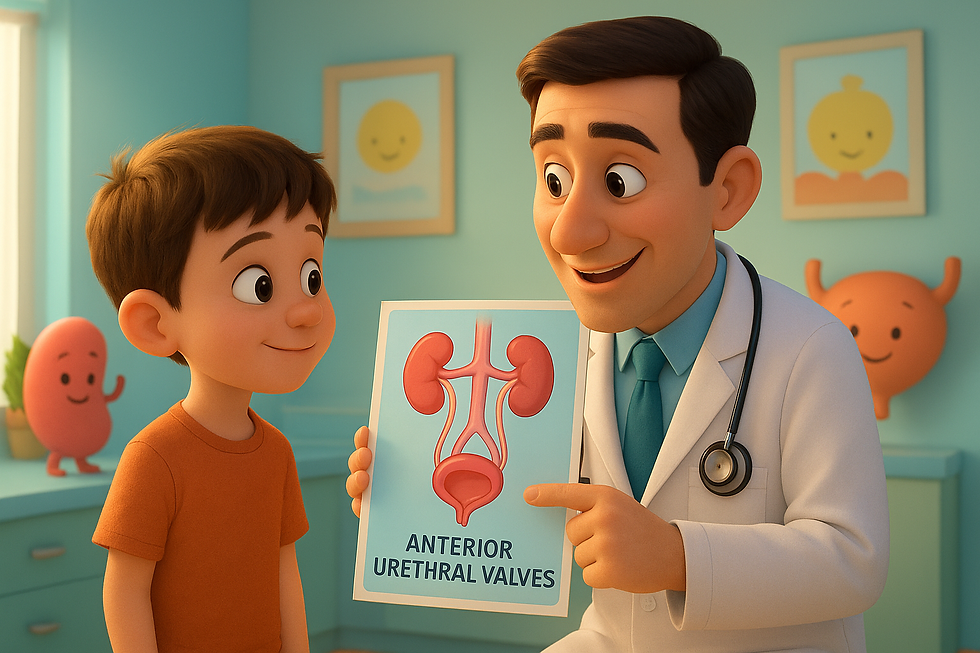"Exploring the Evolution of Paediatric Urology: A Historical Overview"
- Dr Vivek Viswanathan

- Apr 9, 2024
- 3 min read

Historical Overview
Start
↓
Ancient Civilizations (1500 BC):
References to urinary tract diseases and treatments found in Egyptian papyri.
Hippocrates (4th century BC): documented use of catheters.
↓
Middle Ages:
Uroscopy: examining urine for signs of disease (precursor to urinalysis).
↓
Renaissance (16th century):
Ambroise Paré: developed new surgical techniques and instruments for urology.
↓
19th Century:
Pediatrics emerges as a separate medical specialty.
Recognition of children's unique physiological needs.
↓
Early 20th Century:
Hugh Hampton Young: pioneered surgical techniques for adults and children (hypospadias, vesicoureteral reflux).
↓
Mid-20th Century:
Pediatric Urology becomes a recognized subspecialty.
Technological advancements:
Cystoscope
Antibiotics
American Academy of Pediatrics - Section on Urology (1948)
↓
Late 20th Century:
Imaging technology:
Ultrasound
CT scans
MRI scans
Laparoscopic surgery: less invasive procedures, quicker recovery.
↓
Early 21st Century:
Minimally invasive procedures
Robotics in surgery (first robotic procedure in 2002)
↓
Future Prospects
Understanding the evolution of paediatric urology requires a journey back to the early days of medicine. The roots of paediatric urology, like many medical specialties, can be traced to ancient civilizations. Egyptian papyri dating back to 1500 BC include references to diseases of the urinary tract and their treatments. However, it was the Greek physician Hippocrates, often hailed as the father of medicine, who first documented the use of catheters to relieve urinary retention around the 4th century BC.
The Middle Ages saw the advent of uroscopy, a practice where physicians would examine a patient's urine for signs of disease. This rudimentary diagnostic tool was a precursor to modern urinalysis. But it wasn't until the Renaissance that significant advancements were made. The 16th-century French surgeon Ambroise Paré developed new surgical techniques and instruments, many of which were used for urological procedures.
However, the specialty of paediatric urology didn't truly emerge until the 19th century. Before this period, children were treated as small adults, and their unique physiological characteristics were largely ignored. The recognition of paediatrics as a separate medical specialty in the late 19th century paved the way for the development of paediatric urology.
In the early 20th century, the American surgeon Hugh Hampton Young made significant contributions to the field. He developed several innovative surgical techniques, including the first successful radical prostatectomy. His work in paediatric urology included pioneering treatments for hypospadias and vesicoureteral reflux.
By the mid-20th century, paediatric urology had become a recognized subspecialty. The American Academy of Pediatrics established its Section on Urology in 1948, reflecting the growing recognition of the field. In the same era, advancements in technology, such as the development of the cystoscope and the invention of antibiotics, revolutionized the diagnosis and treatment of urological disorders in children.
In the latter part of the 20th century, the use of imaging technology became more prevalent in paediatric urology. The advent of ultrasound, computed tomography (CT), and magnetic resonance imaging (MRI) allowed for more accurate diagnoses and less invasive treatments. The development of laparoscopic surgery in the 1980s and 1990s further transformed the field, allowing for procedures that were less traumatic for patients and resulted in quicker recovery times.
The early 21st century has seen a continued focus on minimally invasive procedures and the use of robotics in paediatric urology. The first robotic-assisted paediatric urology procedure was performed in 2002, and since then, this technology has been increasingly used for a variety of procedures.
Despite its relatively recent emergence as a distinct specialty, paediatric urology has a rich history marked by significant advancements and innovations. From the initial observations of ancient physicians to the sophisticated technology of modern medicine, the field has evolved to provide ever-improving care for children with urological disorders.
As we look to the future, the continued integration of technology and a greater understanding of paediatric physiology promise to propel this field forward, further improving outcomes for our youngest patients.















Comments